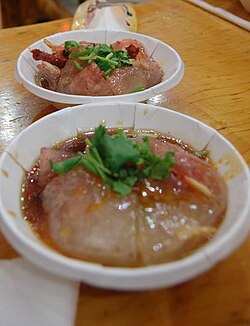Bah-oân
This article includes a list of generalreferences,butit lacks sufficient correspondinginline citations.(March 2016) |
 | |
| Type | Dumpling |
|---|---|
| Course | Dim sum |
| Place of origin | Taiwan |
| Main ingredients | Dough (corn starch,sweet potatostarch,riceflour),pork,chicken,bamboo shoots,shiitakemushrooms |
| Bah-oân | |||||||||||
|---|---|---|---|---|---|---|---|---|---|---|---|
| Traditional Chinese | Nhục viên | ||||||||||
| Literal meaning | meat circle | ||||||||||
| |||||||||||
Bah-oân(Chinese:Nhục viên;pinyin:ròuyuán;Wade–Giles:jou4-yüan2;Pe̍h-ōe-jī:bah-oân;lit.'meat circle') is aTaiwanese street food.
Name[edit]
The term "ba-wan" is a non-standardromanizationderived fromTaiwanese Hokkien.In the township ofLukang,Changhua County,ba-wanare known asbahhoe(Nhục hồi;ròuhuí;bah-hôe;'meat return') because they take on the block-like shape of the character hồi.
History[edit]
It is believed thatba-wanwere first prepared in theBeidoutownship ofChanghua Countyby a scribe by the name of Fan Wan-chu (Phạm vạn cư;Fàn Wànjū) as food for disaster relief, when the region was struck by heavy floods in 1898.[1]Since then,ba-wanhas spread to different regions of Taiwan and is now considered by many as a national food, and can be found in most night markets in Taiwan. The traditional wrapper was made with sweet potato starch alone, sweet potatoes were the dominant food crop in pre-1950s Taiwan and were traditionally preserved by extracting their starch. The ingredients of the ba-wan reflect theterroirof Taiwan.[2]
Production[edit]
The ba-wan is a disk-shaped translucent dough 6–8 cm (2.4–3.1 in) diameter made of sweetpotato starch[3][4]filled with savory stuffing and served with sweet and savory sauce. The stuffing varies widely according to different regions inTaiwan,but usually consists of a mixture ofpork,bamboo shoots,andshiitakemushrooms.[5]Changhua-styleba-wanis considered to be the "standard"ba-wanas it is the most famous and most widely imitated of all styles ofba-wan.[citation needed]
The gelatinous dough is made of a combination ofcorn starch,sweet potatostarch, andriceflour,which gives it its chewy, sticky, and gelatinous texture (sometimes described as "Q"in Taiwanese parlance[6]) and a greyish translucenthue.Ba-wanare initially cooked by steaming; however, they may also be served after beingdeep friedto give them a "skin" or gentlypoachedin oil to heat them without drying them out. Their form makes them relatively easy to pre-make and store. They can be quickly heated again in oil before serving.[2]
See also[edit]
References[edit]
- ^Han Cheung (5 August 2018)."Taiwan in Time: Deadly waters and their legends".Taipei Times.Retrieved5 August2018.
- ^abWei, Clarissa."The Giant Jiggly Crystal Meatball Is the Ultimate Taiwanese Snack".eater.com.Eater.Retrieved18 May2023.
- ^Behnke, A. (2007).Taiwan in Pictures.Visual Geography (Lerner) Series. Twenty-First Century Books. p. 53.ISBN978-0-8225-7148-3.Retrieved5 November2016.
- ^Wong, Maggie Hiufu (24 July 2015)."40 Taiwanese foods we can't live without".CNN.Retrieved5 November2016.
- ^"A beginner's guide to Taiwanese food in London: the best restaurants".Evening Standard.6 May 2015.Retrieved5 November2016.
- ^"For Taiwanese Americans, There's No Better Texture Than Q".KQED.Retrieved2021-12-15.
- Lâm minh đức (2002).Chương hóa huyện ẩm thực văn hóa(in Chinese). Changhua City: Changhua County Cultural Affairs Bureau.ISBN9789570101263.

